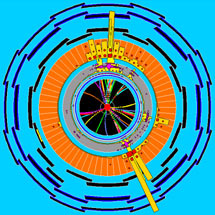
Handy Links
SLAC News Center
SLAC Today
- Subscribe
- Archives: Feb 2006-May 20, 2011
- Archives: May 23, 2011 and later
- Submit Feedback or Story Ideas
- About SLAC Today
SLAC News
Lab News
- Interactions
- Lightsources.org
- ILC NewsLine
- Int'l Science Grid This Week
- Fermilab Today
- Berkeley Lab News
- @brookhaven TODAY
- DOE Pulse
- CERN Courier
- DESY inForm
- US / LHC
SLAC Links
- Emergency
- Safety
- Policy Repository
- Site Entry Form

- Site Maps
- M & O Review
- Computing Status & Calendar
- SLAC Colloquium
- SLACspeak
- SLACspace
- SLAC Logo
- Café Menu
- Flea Market
- Web E-mail
- Marguerite Shuttle
- Discount Commuter Passes
-
Award Reporting Form
- SPIRES
- SciDoc
- Activity Groups
- Library
Stanford
Around the Bay
Strong Dynamics Saves the WIMP
CERN. Click for larger image.)
The Standard Model of particle physics is in excellent agreement with scientific observation, but there are several pieces of evidence indicating that the model is incomplete. Most concretely, the abundant cosmological evidence for dark matter indicates that the universe contains additional particles that comprise the dominant fraction of all matter, yet are not described by the Standard Model. A new addition to theoretical models for the mass and behavior of this particle provides a compelling candidate for the dark matter while staying consistent with current observations.
Among the leading candidates for dark matter are Weakly Interacting Massive Particles, or WIMPs. Theory predicts that the Big Bang would produce a particle which interacts through the Standard Model's weak force and has a mass near the weak interaction energy scale, and that this particle would have a density in the present era compatible with cosmological observations for dark matter. This coincidence—that the energy scale for compelling dark matter is the same as the energy scale of the weak interactions—is striking. The weak interactions also raise their own questions, among them the existence and nature of the Higgs boson. Such questions will soon be probed with data from the Large Hadron Collider; the concordance of energy scales is good reason to hope that the LHC will give evidence on the nature of dark matter as well.
Of the candidates for new physics beyond the Standard Model, supersymmetry is among the most compelling. Supersymmetry is a symmetry relating bosons, the subatomic particles that carry force, and fermions, particles that make up everyday matter, including electrons, neutrinos and quarks. The special properties of supersymmetry offer an explanation of the energy scale of weak interactions. However, we do not see a manifest symmetry between fermions and bosons among the particles that we know, so supersymmetry must be broken—that is, not entirely symmetric—in order to be compatible with observations. Much of the detailed physics that we expect to observe at the LHC depends on the way in which supersymmetry breaking is communicated to the Standard Model particles.
Different models of this communication lead to very different predictions for the dark matter, and for other properties of the supersymmetric model. If supersymmetry breaking is communicated to the Standard Model by gravity, the lightest new supersymmetric particle is often the supersymmetric partner of the photon, and this is an excellent candidate for the dark matter particle. But models of this type do not respect the flavor symmetries of quarks. Often, they predict flavor-changing reactions at levels incompatible with measurements by BaBar, Belle and other experiments on heavy quark weak decays. Another possibility is that supersymmetry breaking is communicated predominantly by the gauge interactions of the Standard Model. In this case, flavor symmetries are respected and flavor-violating effects are small. However, in these models the gravitino, the supersymmetry partner of the graviton, obtains a very small mass. Supersymmetric particles produced in the early universe would decay to this very light gravitino, and the final mass density of dark matter would be much smaller than observations suggest.
However, the conclusion that communication by gauge interactions leads to a light gravitino follows only from the simplest picture of supersymmetry breaking. If supersymmetry breaking were due to new strong interactions, we might find a very different result. In the familiar strong interactions—quantum chromodynamics—the proton mass is generated by strong interaction effects and is much larger than the masses of the quarks from which the proton is made. In a similar way, strong interactions among the particles that cause supersymmetry breaking can significantly modify the masses of supersymmetric particles. Most importantly, it can alter the relationship between the gravitino mass and other superpartner masses.
Recently, we developed a model with strong dynamics in the supersymmetry-breaking sector and supersymmetry breaking communicated by gauge interactions, in which the strong interaction effects create a large enhancement of the mass of the gravitino. In this model, the gravitino can be made heavier than other superparticles without sacrificing the flavor symmetries of the gauge mediation. Through strong dynamics in the supersymmetry-breaking sector, we can realize the full promise of supersymmetry: to create a model compatible with all of our present observations while introducing a new particle that provides a compelling candidate for the dark matter.
—Nathaniel Craig and Daniel Green
SLAC Today, October 30, 2008
